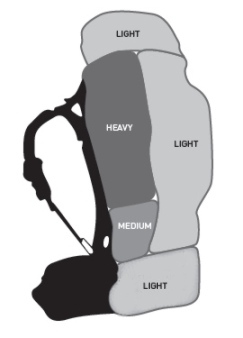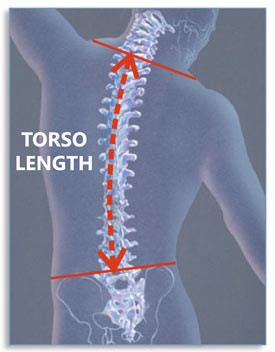I get ideas about what's essential when packing my suitcase. - Diane von Furstenberg
Types
The main types of Bags to choose from are:
- Internal frame - The appeal of internal frames lies in their ability to keep loads stable and walkers balanced on unpredictable terrain.
- External frame - They can help you carry very heavy loads, but generally are best for covering easy terrain. Because they don't lie against the body they are cooler in hot weather.
- Perimeter frame - This design achieves the load-carrying of an external design. It rides like an internal, only without the added weight of internal support stays and a polyethylene framesheet.
- Frameless Rucksack - These are best suited for ultralight backpacking or climbing.
Size (Volume)
The size of your pack depends on several factors. How much gear and provisions you need, the number of days you plan on using it and the season/climate to be used in. Use the following for a rough guideline to pack sizes:
- Less than 3,000 cubic inches - Daypack for winter or mountain outings, or ultralight overnight for warm weather.
- 3,000 to 3,999 cubic inches - Three-season weekend trips, hold all camp gear plus warm clothes and food for a couple of days.
- 4,000 to 5,999 cubic inches - Suitable for a week or more during warm weather or winter weekends.
- 6,000 and more cubic inches - Multiweek treks or gear-heavy winter outings.

Fit
The right backpack should fit your equipment. But just as important, if not more is the way it fits your body. Other factors should include the backpacks durability and its ability to withstand the elements.
If the backpack you choose doesn't fit comfortably you will regret it. One of the primary considerations for a comfortable backpack is to get the right size (e.g., small, medium, large) for your body. Your torso length, not your height, is the key measurement. Hip size is also helpful.
Torso Length
Have a friend locate the bony bump at the base of your neck, where the slope of your shoulder meets your neck. This is your 7th cervical vertebra. Tilt your head forward to locate it more easily. This is the top of your torso length. Place your hands on top of your hip bones (also known as your iliac crest), with fingers pointing forward, thumbs in back. This is the "shelf" on which your pack will rest. The middle of an imaginary line drawn between your thumbs is the bottom of your torso length.
Using a tape measure, measure the distance between the 7th cervical vertebra and the imaginary line between your thumbs. Be sure you stand up straight when being measured. You now should have your torso length.
Use your torso length measurement to find your best pack size. Generally, manufacturers size their pack frames similar to this:
- Extra Small: Fits torsos up to 15"
- Small: Fits torsos 16" to 17"
- Medium/Regular: Fits torsos 18" to 19"
- Large/Tall: Fits torsos 20" and up
Hip Size
The human body's best load-carrying platform is Our hips, part of the pelvic girdle (one of the body's biggest bone structures) which is supported by the body's largest muscle group the quadriceps and hamstrings of the upper legs. Making your hip measurement useful to know. It's especially helpful if you are considering a pack that offers interchangeable hipbelts.
Take the tape measure and wrap it around the top of your hips. The correct measurement is along the "latitude line" that radiates out from your belly button to your sides and the high points of your hip bones. This is slightly higher than your waist, so your hipbelt measurement may differ from your pants waist size.
A properly positioned hipbelt will straddle your hips about an inch above and below that latitude line, wrapping around the 2 pointy pelvic bones on the front of your body. Since it will be supporting your pack's weight, make sure the hip belt provides adequate padding.
Additional Customization Tips
While both torso length and hip size are the primary considerations of pack selection. Careful examination should be applied to suspensions and adjustment straps.
Suspensions: On better quality packs, the shoulder harness can be repositioned to provide a better fit by using adjustable harnesses.
Adjustment points: The weight of a backpack should rest primarily on your hips. Your back, shoulders and upper pectoral region will share in the task secondarily. To optimize comfort and stability, use your pack's adjustment straps.
Load-lifter straps: Kept snug not tight, they prevent the upper portion of a pack from pulling away from your body, which would cause the pack to sag on your lumbar region. Left too loose, they allow the pack to tip backward, compromising balance.
Sternum strap: This mid-chest strap which connects the shoulder straps, helps bring the load weight forward, off your shoulders. They can also help boost your stability.
Stabilizer straps: Found on the side of the hipbelt, they connect the belt to the lower region of the packbag. Keeping them snug improves balance.
Loading Your Pack
Organize your gear in color coded stuff sacks. Red for first aid and repair kits; Blue for kitchen supplies; Brown for clothing systems, etc. Use soft items to pad hard objects to protect your body and the objects themselves. An example might be to place your stove between clothing sacks.
Pack the heaviest gear in the middle of the pack close to your back, this provides the best stability and load transfer. An exception to this is when rock scrambling, bushwacking, or skiing. In those cases you want the heaviest gear in the bottom for a lower center of gravity. Pack clothing and other light gear around heavy items to keep them from shifting around too much.
Water is probably the heaviest and densest single item you carry, so try to keep that near your back.
The sleeping bag is usually pretty light for the space it takes up, so it should go in or on the bottom of the pack. Most packs are designed with a compartment at the bottom for your sleeping bag. If your pack has dividers that separate the sleeping bag from the rest of your gear, use them; it will take damaging compression off a down sleeping bag.

Place gear needed on trail (compass and map) in outer pockets, gear like food or exra clothing layers needed during stops should be placed near the top. Try to store your stove fuel upright and away from your food, in case of an accidental spill. Many hikers put their bottles in an outside compartment. Store you gear in the same place each time you pack; you will automatically know where to find them.
Protection from the Elements
The options are limited for protecting your gear from the elements. Pack covers slap in the wind and are vulnerable to tearing. A better option is use dry sacks or a pack liner.



